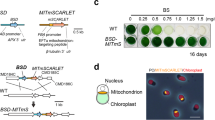Abstract
Proteins derived from the thermophilic cyanobacterium Thermosynechococcus elongatus BP-1, which performs plant-type oxygenic photosynthesis, are suitable for biochemical, biophysical and X-ray crystallographic studies. We found that T. elongatus displays natural transformation, and we established a simple and efficient protocol for transferring exogenous DNAs into the organism’s genome. We obtained transformants directly on selective agar plates without having to amplify them prior to plating. We constructed several targeting vectors that enabled us to insert exogenous DNAs into specific sites without disrupting endogenous genes and operons. We also developed a new selectable marker gene for T. elongatus by optimizing the codons of the gene encoding a kanamycin nucleotidyltransferase derived from the thermophilic bacterium Bacillus stearothermophilus. This synthetic gene enabled us to select transformants as kanamycin-resistant colonies on agar plates at 52°C. Optimization of the conditions for natural transformation resulted in a transformation efficiency of up to 1.7×103 transformants per μg of DNA. The exogenous DNAs were integrated stably into the targeted sites of the T. elongatus genome via homologous recombination by double crossovers.




Similar content being viewed by others
References
Ausubel FM, Brent R, Kingston RE, Moore DD, Seidman JG, Smith JA, Struhl K (1987) Current protocols in molecular biology. Greene Publishing Associates and Wiley-Interscience, New York
Bruns BU, Briggs WR, Grossmann AR (1989) Molecular characterization of phycobilisome regulatory mutants of Fremyella displosiphon. J Bacteriol 171:901–908
Castenholz RW (1988) Culturing methods for cyanobacteria. Methods Enzymol 167:68–93
Elhai J, Vepritskiy A, Muro-Pastor AM, Flores E, Wolk CP (1997) Reduction of conjugal transfer efficiency by three restriction activities of Anabaena sp. strain PCC 7120. J Bacteriol 179:1998–2005
Golden SS, Sherman LA (1984) Optimal conditions for genetic transformation of the cyanobacterium Anacystis nidulans R2. J Bacteriol 158:36–42
Grigorieva GA, Shestakov SV (1982) Transformation in the cyanobacterium Synechocysti s PCC 6803. FEMS Microbiol Lett 13:367–370
Hayashi F, Suzuki H, Iwase R, Uzumaki T, Miyake A, Shen J-R. Imada K, Furukawa Y, Yonekura K, Namba K, Ishiura M (2003) ATP-induced hexameric ring structure of the cyanobacterial circadian clock protein KaiC. Genes Cells 8:287–296
Herdman M, Carr NG (1971) Recombination in Anacystis nidulans mediated by an extracellular DNA/RNA complex. J Gen Microbiol 68:xiv
Hitomi K, Okamoto K, Daiyasu H, Miyashita H, Iwai S, Toh H, Ishiura M, Todo T (2000) Bacterial cryptochrome and photolyase: characterization of two photolyase-like genes of Synechocystis sp. PCC 6803. Nucleic Acid Res 12:2353–2362
Jordan P, Fromme P, Witt HT, Klukas O, Saenger W, Krauss N (2001) Three-dimensional structure of cyanobacterial photosystem I at 2.5 Å resolution. Nature 411:909–917
Kamiya N, Shen J-R (2003) Crystal structure of oxygen-evolving photosystem II from Thermosynechococcus vulcanus at 3.7-Å resolution. Proc Natl Acad Sci USA 100:98–103
Katoh H, Itoh S, Shen J-R, Ikeuchi M (2001) Functional analysis of psbV and a novel c -type cytochrome gene psbV2 of the thermophilic cyanobacterium Thermosynechococcus elongatus strain BP-1. Plant Cell Physiol 42:599–607
Koksharova OA, Wolk CP (2002) Genetic tools for cyanobacteria. Appl Microbiol Biotechnol 58:123–137
Kolowsky KS, Williams JGK, Szalay AA (1984) Length of foreign DNA in chimeric plasmids determines the efficiency of its integration into the chromosome of the cyanobacterium Synechococcus R2. Gene 27:289–299
Matsumura M, Katakura Y, Imanaka T, Aiba S (1984) Enzymatic and nucleotide sequence studies of a kanamycin-inactivating enzyme encoded by a plasmid from thermophilic bacilli in comparison with that encoded by plasmid pUB110. J Bacteriol 160:413–420
Miyake M, Kotani H, Asada Y (1992) Isolation and identification of restriction endonuclease, Sel I, from cyanobacterium, Synechococcus elongatus. Nucleic Acids Res 20:2605
Mühlenhoff U, Chauvat F (1996) Gene transfer and manipulation in the thermophilic cyanobacterium Synechococcus elongatus. Mol Gen Genet 252:93–100
Mühlenhoff U, Haehnel W, Witt HT, Herrmann RG (1993) Genes encoding eleven subunits of photosystem I from the thermophilic cyanobacterium Synechococcus sp. Gene 127:71–78
Nakamura Y, et al (2002) Complete genome structure of the thermophilic cyanobacterium Thermosynechococcus elongatus BP-1. DNA Res 9:123–130
Porter RD (1988) DNA transformation. Methods Enzymol 167:703–727
Sambrook J, Fritsch EF, Maniatis T (1989) Molecular cloning: a laboratory manual (2nd edn). Cold Spring Harbor Laboratory Press, Cold Spring Harbor, New York
Shestakov SV, Khuyen NT (1970) Evidence for genetic transformation in blue-green alga Anacystis nidulans. Mol Gen Genet 107:372–375
Shimizu T, Hiyama T, Ikeuchi M, Koike H, Inoue Y (1990) Nucleotide sequence of the psaC gene of the cyanobacterium Synechococcus vulcanus. Nucleic Acids Res 18:3644
Shimizu T, Hiyama T, Ikeuchi M, Inoue Y (1992) Nucleotide sequence of the psaA and psaB genes encoding the photosystem I core proteins from the cyanobacterium Synechococcus vulcanus. Plant Mol Biol 18:785–791
Stemmer WPC, Crameri A, Ha KD, Brennan TM, Heyneker HL (1995) Single-step assembly of a gene and entire plasmid from large numbers of oligodeoxyribonucleotides. Gene 164:49–53
Sugiura M, Inoue Y (1999) Highly purified thermo-stable oxygen-evolving photosystem II core complex from the thermophilic cyanobacterium Synechococcus elongatus having His-tagged CP43. Plant Cell Physiol 40:1219–1231
Thiel T (1994) Genetic analysis of cyanobacteria. In: Bryant DA (ed) The Molecular biology of cyanobacteria. Kluwer Academic Publishers, Dordrecht, The Netherlands, pp 581–611
Thiel T, Poo H (1989) Transformation of a filamentous cyanobacterium by electroporation. J Bacteriol 171:5743–5746
Yamaoka T, Satoh K, Katoh S (1978) Photosynthetic activities of a thermophilic blue-green alga. Plant Cell Physiol 19:943–954
Zouni A, Witt HT, Kern J, Fromme P, Krauss N, Saenger W, Orth P (2001) Crystal structure of photosystem II from Synechococcus elongatus at 3.8 Å resolution. Nature 409:739–743
Acknowledgements
We thank Drs. Masahiro Takagi (Osaka University) and Tadayuki Imanaka (Kyoto University) for kind gift of the original kanamycin resistance gene from Bacillus stearothermophilus. We also thank Drs. Shigeru Itoh (Nagoya University), Hideo Shinagawa (Osaka University), and Hideaki Nakashima (Okayama University) for critical reading of this manuscript, and Dr. Miriam Bloom (SciWrite, Jackson, Miss.) for professional editing. This study was supported by grants to M.I. from the following sources: the Japanese Ministry of Education, Culture, Sports, Science and Technology (MEXT), the Naito Foundation (Tokyo), the Program for Promotion of Basic Research Activities for Innovative Biosciences (PROBRAIN) promoted by BRAIN, Research for the Future: Novel Gene Function Involved in Higher-Order Regulation of Nutrition-Storage in Plants promoted by the Japan Society for the Promotion of Science, Ground-based Research for Space Utilization, promoted by the Japan Space Forum, and the National Project on Protein Structural and Function Analyses, supported by MEXT, and the Promoting Cooperative Research Project, sponsored by the Aichi Science and Technology Foundation. The Division of Biological Science, Graduate School of Science, Nagoya University is supported by a 21st COE grant from MEXT.
Author information
Authors and Affiliations
Corresponding author
Additional information
Communicated by H. Ikeda
Rights and permissions
About this article
Cite this article
Onai, K., Morishita, M., Kaneko, T. et al. Natural transformation of the thermophilic cyanobacterium Thermosynechococcus elongatus BP-1: a simple and efficient method for gene transfer. Mol Genet Genomics 271, 50–59 (2004). https://doi.org/10.1007/s00438-003-0953-9
Received:
Accepted:
Published:
Issue Date:
DOI: https://doi.org/10.1007/s00438-003-0953-9




